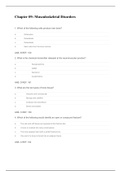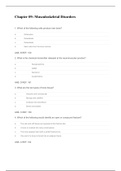Deformed tooth - Study guides, Class notes & Summaries
Looking for the best study guides, study notes and summaries about Deformed tooth? On this page you'll find 28 study documents about Deformed tooth.
Page 3 out of 28 results
Sort by

-
CNRN Exam 349 Questions with Verified Answers,100% CORRECT
- Exam (elaborations) • 31 pages • 2023
-
Available in package deal
-
- $12.49
- + learn more
CNRN Exam 349 Questions with Verified Answers Describe a hangmans fracture - CORRECT ANSWERbilateral fracture through the arch of C2 Tx for hangmans fx? - CORRECT ANSWERHalo or cervical traction Describe a jefferson's fracture - CORRECT ANSWERburst fracture through the arch of c1 Describe anterior cord syndrome - CORRECT ANSWERLoss of motor, pain and temp, but keep deep touch, vibration and position sense Describe brown sequard - CORRECT ANSWERipsilateral motor touch and positi...

-
Ortho EOR exam questions and answers with complete A solutions
- Exam (elaborations) • 18 pages • 2023
-
Available in package deal
-
- $16.49
- + learn more
Ortho EOR exam questions and answers with complete A solutions What are the top 3 causes of AVN trauma, chronic steroid use, and alcohol use For an intertrochanteric femur fracture how does the foot/leg look? surgery? it is externally rotated, abducted and shortened. needs surgery If you have a posterior dislocation of hip what is the leg doing? leg is shortened, flexed, adducted and internally rotated If you have an anterior dislocation of hip what is the leg doing mid...

-
Musculoskeletal Saunders NCLEX with complete solution 2023
- Exam (elaborations) • 27 pages • 2023
-
- $15.49
- + learn more
On a visit to the clinic, a client reports the onset of early symptoms of rheumatoid arthritis. The nurse should conduct a focused assessment for: 1. Limited motion of joints. 2. Deformed joints of the hands. 3. Early morning stiffness. 4. Rheumatoid nodules. - correct answer 3. Initially, most clients with early symptoms of rheumatoid arthritis complain of early morning stiffness or stiffness after sitting still for a while. Later symptoms of rheumatoid arthritis include limited joint range...

-
Unit 19 Nutritional Health
- Essay • 2 pages • 2022
-
- $8.49
- + learn more
Over-nutrition A condition that results from eating too much, or eating too many of the wrong types of food, or taking too many vitamins or other dietary supplements. Deficiency The absence of a particular nutrient in the body, due to a lack in the diet or conditions that prevent nutrients being absorbed from the diet. 00:03 01:29 Antioxidant Substances that may prevent or delay some types of cell damage, such as cancer. Antioxidants are found in many foods, including fruits...

-
Class notes pedodontics
- Class notes • 3 pages • 2023
-
- $8.09
- + learn more
The development of teeth is a complex process that occurs in stages, starting from the early formation of tooth buds to the eruption of fully developed teeth. However, sometimes, developmental disturbances can occur, resulting in anomalies in dental growth and formation. Here is a brief description of developmental disturbances of teeth: Tooth Hypoplasia: Tooth hypoplasia refers to the incomplete or defective development of tooth enamel. It can manifest as white or brown spots, grooves, or pi...

-
PATHO STUDY GUIDE: FINAL EXAM!
- Exam (elaborations) • 75 pages • 2021
-
- $9.99
- + learn more
PATHO STUDY GUIDE: FINAL EXAM! Stress increases functional demand adaptations: hypertrophy, hyperplasia, atrophy, metaplasia, dysplasia) Stress is reversible – when it’s relieved cell returns to normal Irreversible stress – too much damage necrosis Reversible Stress Types 1. Atrophy: decreased size of cell due to decreased functional demand Overall decrease tissue mass Muscle can atrophy if not used because of injury, neuromuscular dysfunction (i.e. spinal co...

-
NURSING NR TESTBANKS|NR 283
- Exam (elaborations) • 73 pages • 2021
-
- $17.49
- 1x sold
- + learn more
Chapter 09: Musculoskeletal Disorders 1. Which of the following cells produce new bone? a. Osteocytes b. Osteoblasts c. Osteoclasts d. Stem cells from the bone marrow ANS: B REF: 159 2. What is the chemical transmitter released at the neuromuscular junction? a. Norepinephrine b. GABA c. Serotonin d. Acetylcholine ANS: D REF: 161 3. What are the two types of bone tissue? a. Vascular and nonvascular b. Spongy and calcified c. Compact and cancellous d. Dense and pliable ANS: C R...

-
NURSING NR TESTBANKS|NR 283 GRADED A VERIFIED
- Exam (elaborations) • 73 pages • 2021
- Available in package deal
-
- $21.49
- + learn more
Chapter 09: Musculoskeletal Disorders 1. Which of the following cells produce new bone? a. Osteocytes b. Osteoblasts c. Osteoclasts d. Stem cells from the bone marrow ANS: B REF: 159 2. What is the chemical transmitter released at the neuromuscular junction? a. Norepinephrine b. GABA c. Serotonin d. Acetylcholine ANS: D REF: 161 3. What are the two types of bone tissue? a. Vascular and nonvascular b. Spongy and calcified c. Compact and cancellous d. Dense and pliable ANS: C R...

Do you wonder why so many students wear nice clothes, have money to spare and enjoy tons of free time? Well, they sell on Stuvia! Imagine your study notes being downloaded a dozen times for $15 each. Every. Single. Day. Discover all about earning on Stuvia


